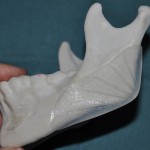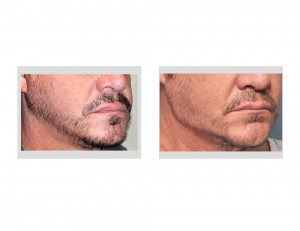Background: A more well-defined jawline has become an aesthetic goal for many men and women today. While twenty years ago it was all about the amount of horizontal chin projection of the front of the jawline (and that is still true today), the back part of the jaw (jaw angles) is also recognized now as significant as well. A more complete approach to jawline aesthetics considers the entire length of the bone from front to back if a better total jawline appearance is to be obtained.
It would be no surprise that if a chin is deficient, the jaw angles may be as well since the development of the lower jaw (mandible) is the same throughout its length. A short chin will often have a high jaw angle as a result of how the bone naturally develops. The position of the lower end of the jaw angle and the chin creates the mandibular plane angle which is steep in many underdeveloped lower jaws.

Case Study: This 48 year-old male wanted to improve the definition/strength of his lower jawline. While he was happy with his chin projection/shape, he felt the back part of his lower jaw was deficient. He wanted stronger jaw angles but also did not want them too big or prominent. He wanted them to fit well into the overall structure of his face.


Case Highlights:
1) A posterior jaw angle deficiency more often than not involves a vertical deficiency as much as any horizontal deficiency. (the high jaw angle)
2) Vertical lengthening jaw angle implants provide a downward and outer rotation to the appearance of the back part of the jaw.
3) Vertical lengthening jaw angle implants require careful pocket dissection to avoid avulsion of the pteryomasseteric sling anatomy and retraction of the masseter muscle superiorly.
Dr. Barry Eppley
Indianapolis, Indiana


